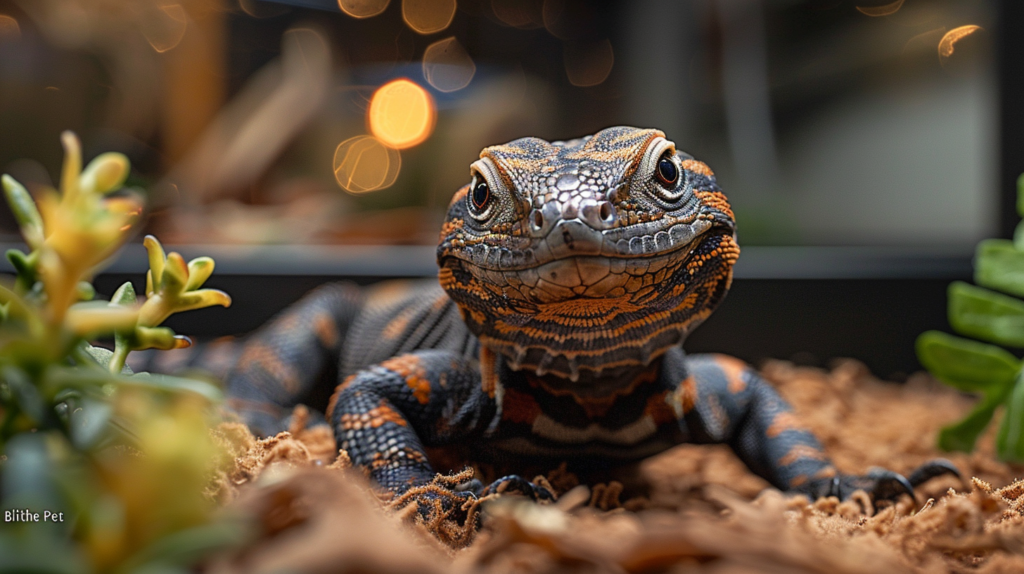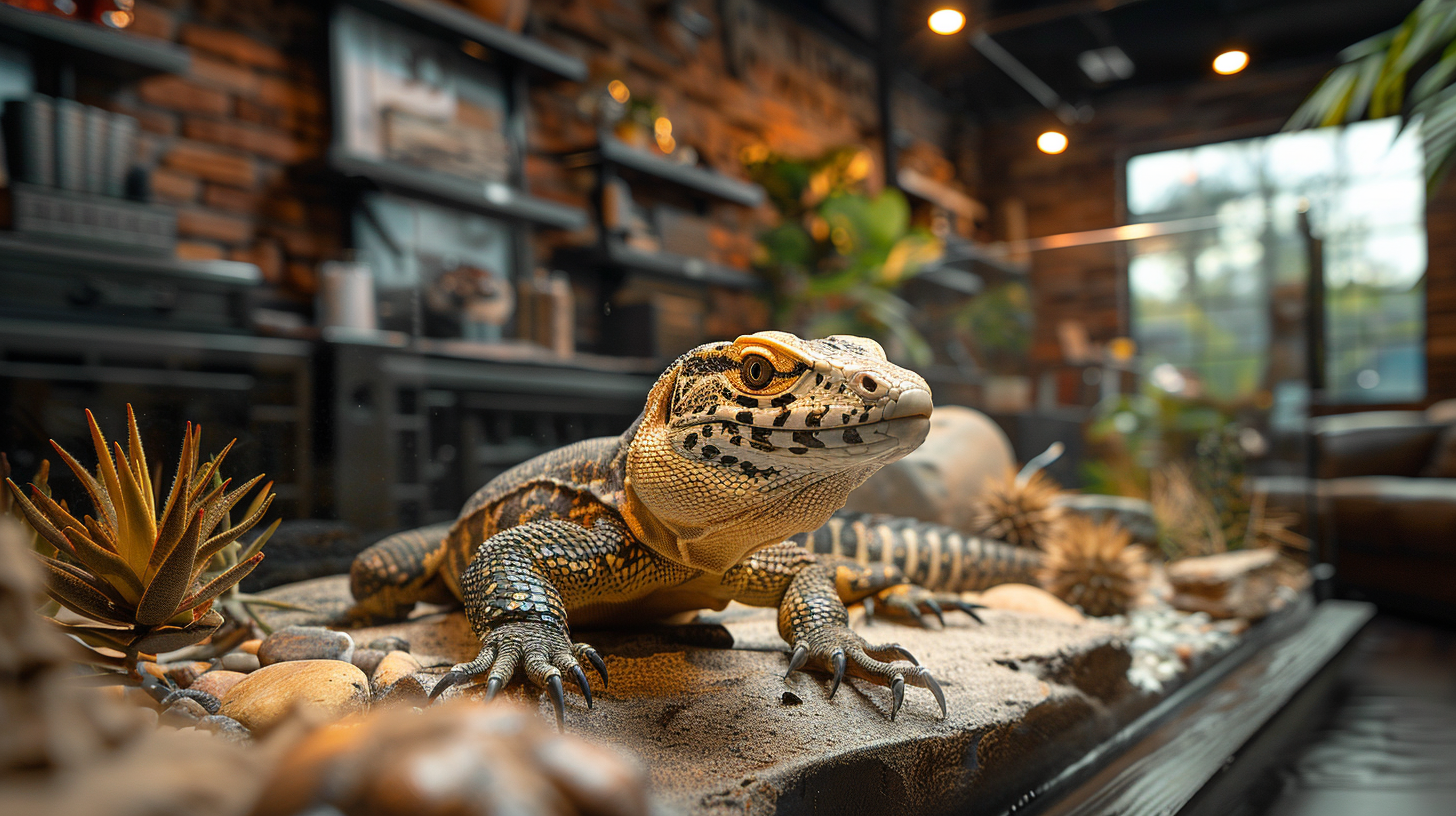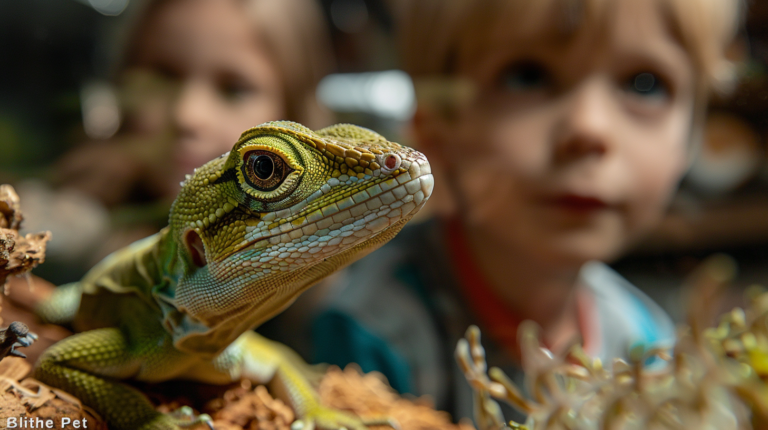Discover 9 essential Savannah Monitor care secrets from expert veterinarians. Complete guide to habitat, diet, health, and behavior for these magnificent reptiles.
Table of Contents
Did you know that Savannah Monitors can live up to 20 years in captivity when provided with proper care? These magnificent African reptiles have captured the hearts of exotic pet enthusiasts worldwide, but their complex needs often catch new owners off guard. The Savannah Monitor (Varanus exanthematicus) isn’t just another lizard—it’s an intelligent, active predator that requires specialized knowledge to thrive in captivity.
When I first encountered a Savannah Monitor at a reptile rescue in Arizona, I was amazed by its alert, almost dog-like behavior. This particular rescue had been surrendered by owners who underestimated the commitment required for proper Savannah Monitor care. The experience taught me that success with these remarkable reptiles hinges on understanding their natural behaviors and recreating appropriate conditions in captivity.
Whether you’re considering adopting your first Savannah Monitor or seeking to improve your current setup, this comprehensive guide reveals the essential care secrets that separate thriving monitors from merely surviving ones. From habitat requirements to dietary needs, we’ll explore evidence-based strategies that ensure your Savannah Monitor lives a healthy, enriched life.

1. Creating the Perfect Savannah Monitor Habitat
Understanding Natural Habitat Requirements
Savannah Monitors originate from the African savannas, where they experience distinct wet and dry seasons, varied terrain, and specific temperature gradients. Replicating these conditions is crucial for their physical and psychological well-being.
The foundation of successful Savannah Monitor care begins with understanding that these lizards are semi-fossorial, meaning they spend significant time both above and below ground. In the wild, they create elaborate burrow systems that provide temperature regulation, security, and nesting sites.
Enclosure Size and Setup
Adult Savannah Monitors require substantial space—a minimum of 8 feet long, 4 feet wide, and 4 feet tall. However, bigger is always better for these active predators. The “bigger is better” principle applies because Savannah Monitors can reach 3-4 feet in length and are incredibly active when properly stimulated.
| Life Stage | Minimum Enclosure Size | Substrate Depth | Temperature Gradient |
|---|---|---|---|
| Juvenile (0-1 year) | 40 gallon long | 6-8 inches | 78-88°F |
| Sub-adult (1-2 years) | 75 gallon | 8-12 inches | 78-90°F |
| Adult (2+ years) | 120+ gallon/Custom | 12-18 inches | 78-95°F |
| Breeding Adult | Custom 8x4x4 ft minimum | 18-24 inches | 78-100°F |
Substrate Selection and Depth
The substrate choice significantly impacts your Savannah Monitor’s ability to exhibit natural behaviors. A proper substrate mixture should consist of 60% organic topsoil, 30% play sand, and 10% cypress mulch. This combination retains moisture for humidity while allowing for tunnel construction.
Avoid substrates like cedar shavings, pine shavings, or loose particulate substrates that can cause impaction. The substrate should be deep enough to allow complete burrowing—typically 12-18 inches for adults.
2. Mastering Temperature and Lighting Requirements
Creating Proper Temperature Gradients
Savannah Monitors are ectothermic, requiring external heat sources to regulate their body temperature. The key to successful thermoregulation lies in creating distinct temperature zones within the enclosure.
The basking area should reach 95-100°F, while the cool side should maintain 78-82°F. Nighttime temperatures can safely drop to 75-78°F. Use multiple thermometers with probes to monitor temperatures at various heights and locations within the enclosure.
UVB Lighting: Non-Negotiable for Health
Unlike nocturnal reptiles, Savannah Monitors require high-quality UVB lighting to synthesize vitamin D3 and properly metabolize calcium. A T5 HO 10.0 or 12% UVB bulb should span at least half the enclosure length and be replaced every 8-10 months.
Dr. Frances Baines, a renowned reptile lighting specialist, emphasizes that “UVB exposure is not optional for diurnal monitor species—it’s fundamental to their bone development, immune function, and overall vitality.”
Heat Sources and Safety Considerations
Primary heat sources should include:
- Ceramic heat emitters for ambient temperature
- Halogen flood lights for basking spots
- Radiant heat panels for gentle nighttime warming
- Under-tank heaters for substrate warming (used cautiously)
Always use thermostats to prevent overheating and ensure consistent temperatures. Multiple heat sources provide redundancy and create more natural temperature variations throughout the enclosure.
3. Humidity Control and Water Features
Maintaining Optimal Humidity Levels
Savannah Monitors require humidity levels between 60-80%, with the ability to access both high and low humidity microclimates. This gradient allows them to choose their preferred conditions based on their current needs—whether shedding, thermoregulating, or simply seeking comfort.
Monitor humidity using digital hygrometers placed at different enclosure levels. The substrate moisture content directly influences ambient humidity, making proper substrate selection and maintenance crucial.
Water Features and Hydration
Provide a large, shallow water bowl that allows your Savannah Monitor to soak completely. The water should be changed every 2-3 days or immediately if soiled. Some monitors prefer moving water, making small pumps or bubblers beneficial additions.
During shedding periods, temporarily increase humidity by misting one section of the enclosure lightly. Never mist the entire enclosure, as this can lead to respiratory issues or fungal growth.
4. Nutrition: Feeding Your Savannah Monitor Properly
Understanding Natural Dietary Patterns
In the wild, Savannah Monitors are opportunistic carnivores with a varied diet including insects, small mammals, birds, eggs, and carrion. Captive diets should reflect this diversity while ensuring proper nutritional balance.
Juvenile Savannah Monitors require daily feeding, while adults should be fed every 2-3 days. Overfeeding is a common problem that leads to obesity and shortened lifespans.
Appropriate Prey Items and Feeding Schedule
| Age Group | Primary Foods | Feeding Frequency | Portion Size |
|---|---|---|---|
| Hatchling | Small crickets, dubia roaches | Daily | 5-8 appropriately sized insects |
| Juvenile | Crickets, roaches, mice pinkies | Daily | 8-12 insects or 1 pinky |
| Sub-adult | Adult insects, small mice, quail | Every other day | 2-3 adult mice or equivalent |
| Adult | Mice, rats, quail, eggs | 2-3 times weekly | 1-2 adult mice or 1 small rat |
Supplementation and Nutritional Balance
Dust prey items with high-quality calcium/D3 supplements twice weekly for juveniles and once weekly for adults. Use a comprehensive reptile multivitamin once weekly. Gut-load feeder insects 24-48 hours before feeding with nutritious foods like leafy greens, carrots, and commercial gut-loading diets.
For more expert pet care tips and product recommendations, visit BlithePet.com your trusted source for pet wellness.
5. Health Monitoring and Veterinary Care
Common Health Issues in Savannah Monitors
Savannah Monitors are susceptible to several health conditions, many of which are preventable with proper husbandry. Understanding early warning signs can mean the difference between minor interventions and serious medical emergencies.
Metabolic bone disease ranks among the most serious conditions, typically resulting from inadequate UVB lighting, poor calcium supplementation, or improper diet. Early signs include soft jaw, tremors, and difficulty moving.
Warning Signs to Watch For
Monitor your Savannah Monitor daily for these concerning symptoms:
- Lethargy or decreased activity levels
- Loss of appetite lasting more than one week
- Visible weight loss or prominent hip bones
- Respiratory distress (mouth breathing, wheezing)
- Abnormal shedding patterns or retained shed
- Changes in stool consistency or color
- Swelling around joints or extremities
- Unusual aggression or behavioral changes
Establishing Veterinary Relationships
Before acquiring a Savannah Monitor, research exotic veterinarians in your area. Not all veterinarians are qualified to treat monitor lizards, and emergency situations require immediate expert care.
Schedule annual wellness examinations even for apparently healthy monitors. These visits allow for fecal parasite screening, weight monitoring, and early detection of subtle health changes.
6. Behavioral Understanding and Enrichment
Natural Behaviors and Intelligence
Savannah Monitors display remarkable intelligence compared to many reptile species. They can recognize their caregivers, learn feeding routines, and even respond to environmental cues. Understanding their natural behaviors helps create appropriate captive environments.
In the wild, these monitors spend their days actively foraging, with peak activity during morning and late afternoon hours. They’re excellent climbers despite their terrestrial reputation and enjoy exploring vertical spaces.
Environmental Enrichment Strategies
Enrichment prevents boredom and promotes natural behaviors. Effective enrichment for Savannah Monitors includes:
- Rotating hiding spots and climbing structures
- Puzzle feeders that encourage foraging behavior
- Substrate changes that require re-exploration
- Safe branches and platforms for climbing
- Occasional supervised exploration outside the enclosure
Case Study: The Milwaukee Zoo reported significant improvements in their Savannah Monitor breeding success after implementing rotation enrichment programs. Monitors showed increased activity levels, better appetite, and more natural reproductive behaviors.
Handling and Socialization
Young Savannah Monitors can be gradually acclimated to gentle handling, but respect their individual personalities. Some monitors enjoy brief interaction sessions, while others prefer minimal contact. Always support their body weight and avoid restraining them unnecessarily.
Never attempt to handle a monitor during shedding, immediately after feeding, or when they display defensive postures like tail whipping or inflated throat displays.
7. Common Mistakes and How to Avoid Them
Myth-Busting: Separating Fact from Fiction
Myth 1: Savannah Monitors stay small in small enclosures This dangerous misconception leads to stunted growth, behavioral problems, and shortened lifespans. Savannah Monitors reach their genetic size potential regardless of enclosure size—small enclosures simply create stress and health issues.
Myth 2: They can survive on a diet of only crickets A cricket-only diet lacks essential nutrients and leads to metabolic bone disease. Savannah Monitors require dietary variety including whole prey items to maintain optimal health.
Myth 3: They don’t need UVB lighting like other reptiles All diurnal monitor species, including Savannah Monitors, require high-quality UVB exposure for proper calcium metabolism and immune function.
Critical Setup Mistakes
The most common setup failures include:
- Insufficient substrate depth preventing natural burrowing
- Poor temperature gradients causing stress
- Inadequate humidity leading to shedding problems
- Undersized enclosures restricting natural movement
- Improper lighting schedules disrupting circadian rhythms
Feeding and Care Errors
Overfeeding represents the single most common care mistake. Obesity in Savannah Monitors leads to liver disease, reproductive problems, and significantly shortened lifespans. Adult monitors should have a visible waist when viewed from above and should not have fat deposits around the neck or limbs.
8. Breeding Considerations and Life Stages
Understanding Reproductive Maturity
Savannah Monitors reach sexual maturity at 2-3 years of age, though successful breeding typically occurs at 3-4 years. Breeding requires substantial preparation, including proper conditioning, appropriate seasonal cycling, and extensive space requirements.
Breeding Savannah Monitors is not recommended for novice keepers due to the complexity of care, space requirements, and long-term commitment involved in raising offspring.
Seasonal Cycling and Brumation
Adult Savannah Monitors benefit from seasonal temperature and photoperiod cycling that mimics their natural environment. This cycling supports healthy hormone production, proper metabolism, and natural behavioral patterns.
During cooler months (November-February), gradually reduce temperatures by 5-8°F and shorten daylight hours to 8-10 hours. This modified brumation period promotes natural rhythms and can improve overall health.
Lifespan and Long-term Commitment
With proper care, Savannah Monitors can live 15-20 years in captivity. This substantial commitment requires consistent care, potential veterinary expenses, and dedication through various life stages. Consider your long-term ability to provide appropriate care before acquiring these remarkable reptiles.
9. Setting Up for Success: Step-by-Step Guide
Pre-Acquisition Preparation Checklist
Before bringing home your Savannah Monitor, ensure you have:
- Enclosure Setup: Complete with proper substrate, heating, lighting, and hiding spots
- Temperature Monitoring: Multiple thermometers and backup heating systems
- Food Supply: Established sources for varied prey items
- Veterinary Contact: Located and contacted exotic-qualified veterinarian
- Emergency Plan: Backup power for heating/lighting during outages
Week-by-Week Acclimation Process
Week 1-2: Minimal interaction, allow exploration and establishment of territory Week 3-4: Begin regular feeding schedule and daily health observations Week 5-8: Gradually introduce enrichment items and begin trust-building Week 9-12: Establish long-term care routines and consider gentle handling
Monitoring Success Indicators
A successfully acclimated Savannah Monitor will display:
- Active exploration and foraging behaviors
- Consistent appetite and regular defecation
- Alert, responsive demeanor during active periods
- Proper shedding cycles every 6-8 weeks
- Steady weight gain in young monitors
- Use of temperature gradient and hiding spots
| Success Indicator | Healthy Behavior | Warning Signs |
|---|---|---|
| Activity Level | Active exploration, climbing | Excessive hiding, lethargy |
| Appetite | Eager feeding response | Refusing food >1 week |
| Body Condition | Visible muscle tone, healthy weight | Visible ribs, fat deposits |
| Shedding | Complete sheds every 6-8 weeks | Retained shed, incomplete sheds |
| Temperament | Alert but calm demeanor | Excessive aggression or stress |
FAQ Section
Conclusion
Successfully caring for a Savannah Monitor requires dedication, knowledge, and substantial resources, but the rewards of sharing your life with these intelligent reptiles are immense. These nine essential care secrets form the foundation of proper Savannah Monitor husbandry: appropriate habitat size, proper temperature gradients, UVB lighting, humidity control, varied nutrition, health monitoring, behavioral understanding, mistake avoidance, and systematic setup approaches.
Remember that Savannah Monitor care is not just about meeting minimum requirements—it’s about creating an environment where these remarkable animals can thrive and express their natural behaviors. The investment in proper setup and ongoing care pays dividends in the form of a healthy, long-lived companion that can bring decades of fascination and joy.
The key to success lies in research, preparation, and ongoing commitment to excellence in husbandry practices. Every Savannah Monitor deserves an owner who understands their complex needs and provides appropriate care throughout their potentially 20-year lifespan.
Have a similar experience with your pet? Share it in the comments below! Don’t forget to check out our other helpful guides at BlithePet.com.







